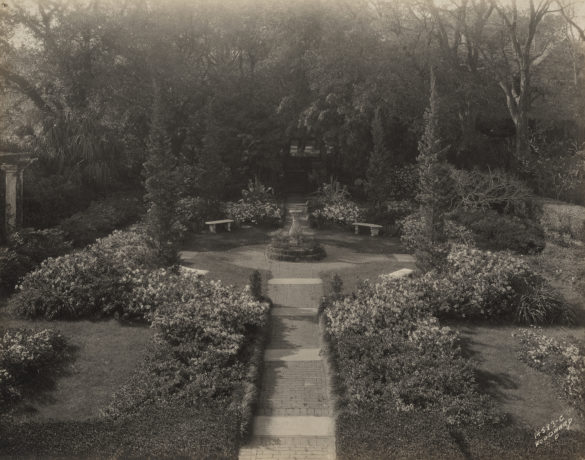WRITTEN BY HEATHER STEWART, MARKETING INTERN
 Thumbing through pictures of the Gardens from the 1920s and 30s, it’s easy to see, even in sepia tones, their stunning beauty. Brimming with hundreds of blooms from daylilies, peonies, iris, cannas, and roses, it was a spectacular sight. Petunias, snapdragons, and candytuft blossomed while white clematis, red passion flowers, and Japanese and Chinese wisteria perfumed the air.
Thumbing through pictures of the Gardens from the 1920s and 30s, it’s easy to see, even in sepia tones, their stunning beauty. Brimming with hundreds of blooms from daylilies, peonies, iris, cannas, and roses, it was a spectacular sight. Petunias, snapdragons, and candytuft blossomed while white clematis, red passion flowers, and Japanese and Chinese wisteria perfumed the air.
The basic design of the English Garden was created by Philadelphia nurserymen Thomas Meehan and Sons and still exists to this day. The centerpiece of this Garden is the large rectangular arbor covered in wisteria, roses, and clematis. Beautifully-laid brick paths alternate with grass walkways to guide visitors to the cypress-beamed pergola that overlooks the water.
The English Garden was typical of an era marked by large estates that required a groundskeeper. Annuals and perennials were planted on a seasonal rotation, and maintenance was a year-round activity. Pruning, starting seeds, and cutting fresh flowers for the home were daily chores of the gardener.
Gardener Bernd Marzulla has a long-term goal to restore the gardens, which are listed on the National Register of Historic Places, to their condition circa 1930. It’s not a simple project, as it demands spending hours reviewing old blueprints and handwritten notes. Then there is the challenge of finding out if those plants are still available. It’s a laborious process, but one born of passion, and Marzulla is up to the task.
Proceeds from Garden Month 2017 will be used to restore the English Garden. Using historic photos like this one in the Cummer Archives, Staff and volunteer Carolyn Marsh Lindsay, under the guidance of the Museum’s Garden Committee, have created a plan to restore Ninah Cummer’s first garden to its period of significance. Mrs. Cummer, an avid gardener, actively changed and augmented her gardens throughout her lifetime, but the 1930s represent a peak period of design for all of the Gardens on the Cummer campus. It is that period we seek to show when the Garden is restored.
If you would like to support this important initiative, please contact the Advancement Office at 904.899.6027.


